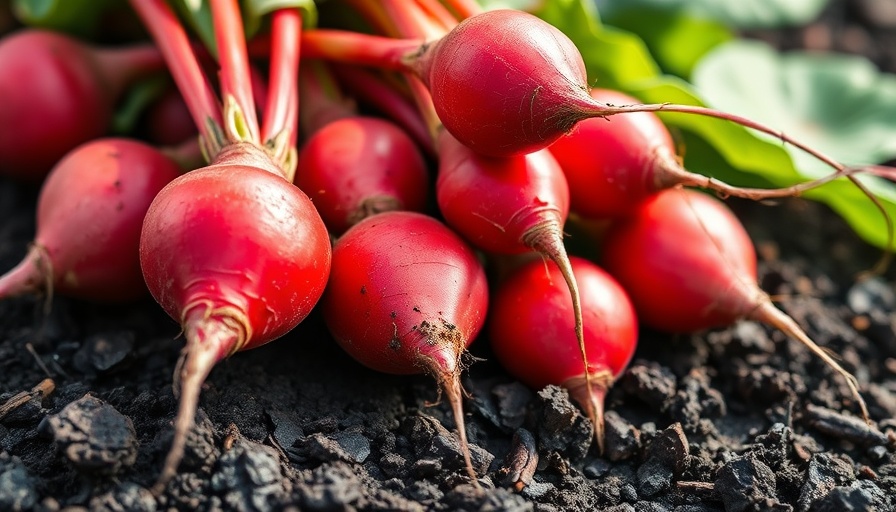
Unlock the Secrets: When to Harvest Your Radishes
Radishes are not just visually enticing in the garden with their vivid colors; they are also a delight for the palate and packed with nutrients. Perfect for both novice gardeners and seasoned green thumbs, understanding when to harvest your radishes can elevate your home garden experience. Depending on the variety, radishes can take anywhere from 20 to 90 days to mature, and the timing of their harvest is crucial to achieving that perfect crunch and flavor.
Chart Your Course: A Timeline for Harvesting
To maximize your radish harvest, it's essential to keep track of their growth cycle. Seed packets offer critical information on days to maturity—making it easier to plan your gardening schedule. Cultivars like 'Cherry Belle' are ready in an astonishingly short 22 days, while larger varieties, such as daikons, may take up to 90 days. Keeping a journal or planner can help you stay on track, allowing you to count down to the big day. Your garden notes might also serve as a helpful reminder for seasons to come.
Harvesting Small Radishes: Techniques for Success
Harvesting small radishes is a straightforward process that merely requires a gentle pull. For round varieties like the 'Early Scarlet Globe' or heirloom types such as 'French Breakfast,' locating the base and tugging softly should free them from the soil without damaging the roots. Depending on your soil type, you might find it helpful to use a spading fork to loosen the ground before harvesting. Pull them up carefully to ensure the entire root is intact, as broken roots can lead to spoilage.
Larger Varieties: The Right Approach
When it comes to harvesting larger radish types, such as 'Green Luobo,' perseverance is key. With thicker roots that can reach up to three or four inches wide, larger radishes sometimes require a little more coaxing. As you begin to pull, gently twist the radish to help ease it out. If you meet resistance, ensure that the root has matured enough and consider using a trowel to gently pry it loose from its earthy home.
Benefits of Harvesting at the Right Time
Timing is everything in gardening, especially with radishes. Harvesting them at their peak not only maximizes flavor but also enhances their nutritional value. Young radishes are known for their crispy texture and zesty crunch, making them ideal for fresh salads or as a sprinkle on various dishes. They become woody and less appealing if left too long in the ground, so timely harvesting can convert a simple salad into a gourmet touch.
Seasonal Considerations for Urban Gardeners
If you're gardening in an urban environment, local climate conditions can impact your radish growth. They thrive in cooler temperatures, making spring and fall the ideal seasons for sowing. However, with urban heat islands increasingly affecting local weather, consider shade gardening practices to provide your plants with some relief. Mulching can also help retain soil moisture while keeping the roots cool and healthy.
Preparing Your Radishes for Consumption
Once harvested, the next step is to properly prepare your radishes for eating or storage. Wash them thoroughly under cold water to remove any residual soil before slicing or cooking. They can be enjoyed fresh, pickled, or even roasted, allowing you to incorporate them into various cuisines. Properly stored, radishes can last for days, ensuring you can enjoy your harvest for an extended period.
Future Planting: Learning from Your Harvest
Every harvest is an opportunity for reflection and planning. After enjoying your radish crop, take notes on what worked well and what could be improved for next season. For example, noting which varieties thrived in your specific conditions can guide your choices for future planting. Additionally, you might consider companion planting; certain plants can deter pests and enhance the flavor of your radishes, enriching your gardening experience further.
Conclusion: Join the Gardening Movement
With a little knowledge and patience, harvesting radishes can become a rewarding experience that connects you with nature and enriches your meals. Whether you are a budding gardener or a seasoned pro, embrace the opportunity to explore the world of radishes, and share your culinary creations with family and friends. Start your adventure today by planting radishes and enjoy the bounty they bring to your table!
 Add Row
Add Row  Add
Add 




 Add Row
Add Row  Add
Add 

Write A Comment